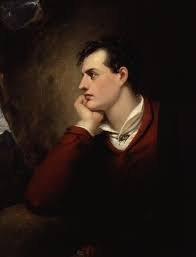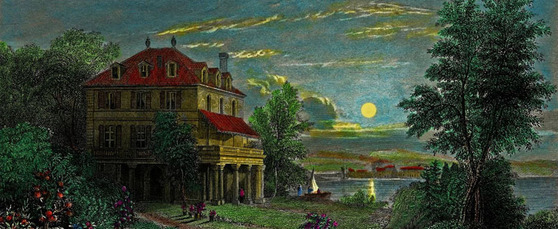And now, once again, I bid my hideous progeny
go forth and prosper. I have an affection for it, for it was the offspring of
happy days, when death and grief were but words, which found no true echo in my
heart . . . Mary Shelley
Mary Shelley and the Ghost of Frankenstein's Monster
It is nearly two hundred years since the 1818 publication of Mary Shelley’s Frankenstein, but the nameless creature that would make her name famous continues to haunt our dreams to this day. (In the novel, Victor Frankenstein is the doctor; his monster is never given a name.) It is as surprising to us as it was to the public back then that one of the most terrifying stories every penned sprang from the imagination of a eighteen year old girl. But although Frankenstein brought Mary Shelley a degree of wealth and fame, it also seemed to unleash a curse that haunted Mary throughout her life.
Portrait of a young Mary Shelley
The Year Without a Summer
Mary’s early years were stained by scandal. At age 17, she eloped with the ethereal (and frequently histrionic) poet Percy Bysshe Shelley. Accompanied by her sister, Claire Claremont, the three fled England for Europe trailing a comet’s tail of angry parents, public disapproval, and disgruntled creditors. The English public was outraged because Percy was a married man who had abandoned his young wife and child. Living like penniless vagabonds, the three traipsed across the Continent dodging bills and sleeping where they could. Sadly, it was a pattern that would be repeated for many years.
Percy Bysshe Shelley
The three absconded to Switzerland, where they met up with Lord Byron, the most notorious romantic poet of the age. The publication of Byron’s first book of cantos Childe Harold’s Pilgrimage, had brought the aristocrat instant fame and made him the toast of Regency London. With his good looks and scandalous reputation for love affairs (with both men and women, and his half-sister) Byron became the Regency equivalent of a rock star, most famously described by his one-time lover, Lady Caroline Lamb, as “Mad Bad, and Dangerous to know.”
Lord Byron, "Mad, Bad and Dangerous to know"
Accompanied by his personal
physician, Dr. John Polidori, Byron rented the Villa Diodati on the shores of
Lake Lucerne. Despite being in one of the most romantic and idyllic
landscapes in the world, 1816 was known as the “year without a summer,” as the
volcano at Mount Tambora erupted, hurling tons of dust into the atmosphere and
darkening the world’s skies to a degree that crops failed in Europe and North
America, causing famine. On the rare occasions of fine weather, Byron and
Shelley sailed together on the lake; however, on most days incessant rain and
violent storms confined the party to the villa’s gloomy rooms. Here, before a
roaring fire, they would talk long into the night, reading poetry and
indulging in deep philosophical discussions about social justice,
atheism and other forbidden topics.
The Villa Diodati
Lord Byron’s Challenge
It was on one such night that
marked the nativity of Mary Shelley’s undying monster. Byron was fond of reading
from a book of German ghost stories, and on this occasion he threw down a
challenge, suggesting that each member of their cadre (Shelley, Byron, Claire, and Polidori) should attempt to write a ghost tale. Percy Shelley was the first to
abandon the challenge, complaining that he was a poet and not a prose writer.
Byron also scribbled something but soon expressed dissatisfaction with his effort and
abandoned the project. Polidori wrote a story about a lady who peeked upon
something forbidden and was punished by having her head turned into a skull.
Although the others made fun of the story, Polidori’s second attempt, The
Vampyre, is generally acknowledged as the progenitor of the modern vampire
story.
Dr. John Polidori
Mary Shelley remained uninspired
for several days, but on an night of apocalyptic thunderstorms she awakened
from a dream in which she glimpsed a vision of a darkened garrette and a doctor
of medicine who had fashioned a man sewn together from corpses stolen from a
charnel house. Brought to life by the workings of “a dread engine” (although
the book is filled with electrical allusions, she was coy about the actual creative mechanism), the creature stirs, the yellow eyes peel open, and the doctor flees
in terror from is own creation. But abandoning his unnatural child invokes a
curse that will follow Victor Frankenstein so where he flees, bringing death,
destruction and tragedy. Given Mary Shelley’s tormented life, it could be
argued that the author of Frankenstein became a victim of the same curse.
Later Portrait of Mary Shelley
A life of Turmoil
The author’s life began tragically,
with the loss of her own mother who died just three weeks after giving birth.
Over the years, the toll of tragedy would mount and Mary suffered from terrible depression at the loss of so many friends and family. Mary’s husband, Percy
Bysshe Shelley drowned after recklessly taking out a sailboat during a storm.
He would later be cremated on the beach and for the rest of her life Mary would carry around his heart in
a silk bag. (Percy Bysshe Shelley’s heart, calcified from an early bout with tuberculosis,
failed to burn.) Mary would suffer the loss of three children either in birth
or by disease in childhood. During one such pregnancy she haemorrhaged and only
Percy Shelley’s insistence that she staunch the bleeding by sitting in a bath
of ice water saved her life.
Shelley’s first wife, Harriet Westbrook, famously drowned herself in
Hyde Park’s Serpentine River. Mary’s maternal half-sister took an overdose of
laudanum. Byron would die of fever while fighting with the Greeks against the
Ottoman Turks, and Dr. John William Polidori, crushed by depression and gambling
debts, swallowed a fatal dose of Prussic Acid.
Benedict Cumberbatch as the monster
Even in later life, Mary was dogged
by scandal. On three occasions she was blackmailed by male acquaintances who
threatened to compromise her by publishing intimate letters she had sent to
them. As if that was not suffering enough, Mary’s final years were marred by
headaches and paralysis from a brain tumour that finally took her life at age 53.
Robert Deniro as the monster
The Ghost of Frankenstein
Despite her tragic life, Mary
Shelley is celebrated today as one of the great innovators in literature.
Frankenstein was arguably the first science fiction novel and has inspired countless
television and movie versions and left an indelible mark upon the human
psyche.
Boris Karloff, Arguably the most famous Frankenstein's monster of all









That was a lovely hint...now please tell me a new novel on this topic is in the offing...
ReplyDelete